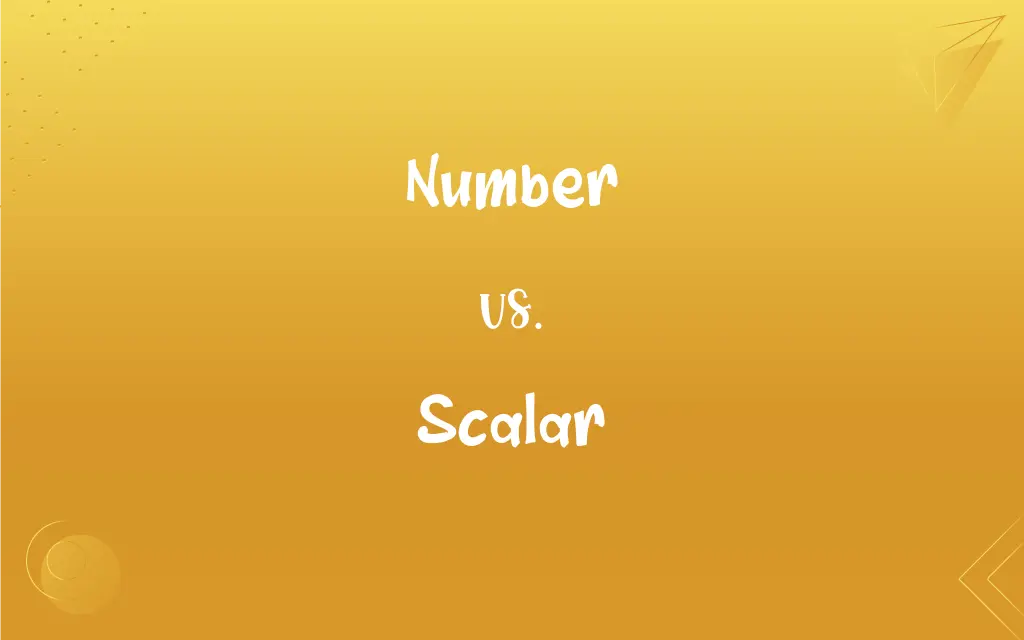Number vs. Scalar: What's the Difference?
Edited by Janet White || By Harlon Moss || Updated on November 13, 2023
A number is a mathematical object used to count, measure, and label, while a scalar is a quantity with only magnitude, not direction, often represented by numbers in mathematics.

Key Differences
A number is a basic concept in mathematics and can be an integer, decimal, or fraction used for counting and calculation. A scalar, on the other hand, is a specific type of quantity in physics and mathematics that has magnitude but no direction.
Numbers are fundamental in various mathematical concepts, from simple arithmetic to complex equations. Scalars are used in physics to represent quantities like temperature or mass, which are fully described by a magnitude alone.
The concept of a number is universal in mathematics, serving as the building block for more complex mathematical structures. Scalars, in contrast, are a specific concept used primarily in the context of vector spaces and physics.
Numbers can exist independently and are used in everyday life for various purposes, such as counting objects or measuring distances. Scalars are often numerical but are defined by their lack of direction, differentiating them from vectors.
Numbers can be real, imaginary, rational, or irrational, showing their diverse nature in mathematics. A scalar, while it can be represented by a number, is specifically defined by its role in a mathematical or physical context where only magnitude is relevant.
ADVERTISEMENT
Comparison Chart
Definition
Mathematical object for counting, measuring
Quantity with magnitude, no direction
Usage
Universal in mathematics and daily life
Specific to physics and vector spaces
Properties
Can be integer, decimal, fractional
Always has only magnitude
Context
Independent and diverse applications
Used in relation to vectors and physical quantities
Varieties
Real, imaginary, rational, irrational
Represented numerically, but defined by absence of direction
ADVERTISEMENT
Number and Scalar Definitions
Number
A number is a mathematical object used for counting.
The number of students in the class is 25.
Scalar
A scalar is a quantity in physics and mathematics that has only magnitude.
The scalar value of temperature in the room is 22 degrees Celsius.
Number
Numbers can indicate position in a series or order.
She finished third, a proud number for her first competition.
Scalar
A scalar is a real number in the context of vector spaces.
In vector multiplication, 3 is a scalar multiplying the vector.
Number
Numbers are used in mathematical calculations.
Adding the numbers 5 and 3 gives 8.
Scalar
In computing, a scalar refers to a single value, as opposed to a set or array.
The variable 'x' was assigned a scalar value of 5.
Number
A number can represent a quantity in measurement.
The recipe calls for 2 cups of flour.
Scalar
A scalar quantity is used to represent measurements that do not have direction.
Mass, a scalar quantity, for the object is 10 kilograms.
Number
A number is used for labeling, like in a sequence.
The number on my race bib for the marathon is 102.
Scalar
Scalars are numerical values in equations representing magnitude.
The pressure of the gas, a scalar, was measured at 30 psi.
Number
A member of the set of positive integers; one of a series of symbols of unique meaning in a fixed order that can be derived by counting.
Scalar
A quantity, such as mass, length, or speed, that is completely specified by its magnitude and has no direction.
Number
A member of any of the following sets of mathematical objects
Integers, rational numbers, real numbers, and complex numbers. These sets can be derived from the positive integers through various algebraic and analytic constructions.
Scalar
(Mathematics) A number, numerical quantity, or element in a field.
Number
Numbers Arithmetic.
Scalar
A device that yields an output equal to the input multiplied by a constant, as in a linear amplifier.
FAQs
What is a number?
A number is a mathematical object used for counting, measuring, and labeling.
How are numbers used in everyday life?
Numbers are used for counting, timekeeping, measuring, and more in daily activities.
What is a scalar?
A scalar is a quantity that has magnitude but no direction, often represented by numbers.
Can a number be negative?
Yes, numbers can be positive, negative, or zero.
What is an example of a complex number?
A complex number has a real and an imaginary part, like 3 + 4i.
Do scalars have units?
Scalars often have units, like meters or seconds, depending on what they measure.
Are scalars always positive?
Scalars can be positive, negative, or zero, as they represent magnitude.
Where are scalars used?
Scalars are used in physics and mathematics, particularly in vector spaces.
Can numbers be fractional?
Yes, numbers can be whole, fractional, or decimal.
Is temperature a scalar?
Yes, temperature is a scalar as it has magnitude only, without direction.
Can a scalar be zero?
Yes, a scalar can be zero, indicating no magnitude.
Can numbers represent abstract concepts?
Yes, numbers can represent or symbolize abstract concepts in various contexts.
Are numbers used in all types of mathematics?
Yes, numbers are fundamental and used in all branches of mathematics.
How are scalars different from vectors?
Scalars have magnitude only, while vectors have both magnitude and direction.
Are scalars always represented by real numbers?
Mostly, but in some mathematical contexts, scalars can be complex numbers.
Is the concept of a number universal?
Yes, the concept of a number is universal across cultures and languages.
Can scalars be used in calculations like numbers?
Yes, scalars can be used in calculations, often as numerical values in equations.
What is the difference between numbers and numerals?
Numbers are concepts, while numerals are symbols or groupings of symbols representing numbers.
Are all numbers integers?
No, numbers include integers, fractions, decimals, and more.
Is velocity a scalar?
No, velocity is a vector as it includes both magnitude and direction.
About Author
Written by
Harlon MossHarlon is a seasoned quality moderator and accomplished content writer for Difference Wiki. An alumnus of the prestigious University of California, he earned his degree in Computer Science. Leveraging his academic background, Harlon brings a meticulous and informed perspective to his work, ensuring content accuracy and excellence.
Edited by
Janet WhiteJanet White has been an esteemed writer and blogger for Difference Wiki. Holding a Master's degree in Science and Medical Journalism from the prestigious Boston University, she has consistently demonstrated her expertise and passion for her field. When she's not immersed in her work, Janet relishes her time exercising, delving into a good book, and cherishing moments with friends and family.































































